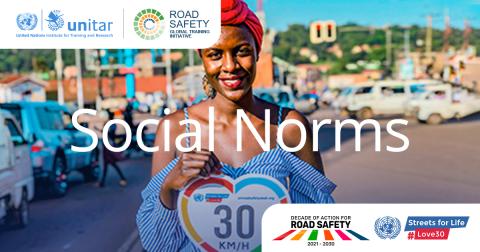
UNITAR Online Catalogue
Social Norms aimed at improving road safety: Designing effective behaviour change campaigns

人类
背景信息
Road traffic injuries claim more than 1.35 million lives each year with a disproportionate impact on health and development. They are the eighth leading cause of death across all age groups globally and the leading cause among children and young people aged between 5 and 29 years, costing governments approximately 3% of GDP and 5% in low- and middle-income countries (World Health Organization, 2018).
Accelerating progress towards safer roads includes adopting and enforcing laws to tackle risk factors associated to road traffic injuries. At the same time, law enforcement has been proven to be more effective when accompanied by effective communication campaigns and strategies aimed at changing road users’ behaviours.
Social norms theory has been examined mainly in public health related fields from the Reasoned Action Approach (Fishbein, Martin, & Ajzen, I.,1975)1, showing that social norms are highly influential in shaping individual behaviour. A social norm is a perception about what others do (what is normal) and what is expected of what others do within the group (what is appropriate)2.
Research shows that social norms are powerful considering the individual need to belong and to “fit in” with their group. Social norms can function like actual laws and violators of social norms are socially sanctioned. They act as rules that define acceptable, appropriate, and obligatory actions in a given group or society. Furthermore, they can influence behaviour despite conflicting individual opinions. Understanding how social norms act as powerful constraints on individual attitudes and behaviours is crucial for effective policy interventions. Moreover, changing road users’ behaviour on the risk factors for road traffic injuries (speed, drink–driving, and the failure to use helmets, seat belts and child restraints properly or at all) is essential to improve road safety.
--------
1 Fishbein, Martin and Icek Ajzen (1975). Belief, Attitude, Intention and Behavior: An Introduction to Theory and Research.
2 Elizabeth Levy Paluck and Laurie Ball (2010). Social norms marketing aimed at gender-based violence: A literature review and critical assessment.
活动目标
The objective of this e-Learning course is threefold:
- Provide an introduction to social norms and its role in creating new and/or perpetuating beneficial norms affecting road safety, as well as in eliminating harmful ones.
- Outline examples of interventions such as road safety campaigns that seek to alter social norms in support of road safety.
- Offer a guide on how to design effective communication campaigns aimed at changing road users’ behaviours.
学习目标
By the end of this course, participants will be able to:
- Understand the theoretical framework around social norms and its link to improve road safety
- Explore case studies applied to road safety where effective communication campaigns had an impact on social norms in support of road safety
- Design succesful campaigns aimed at changing road users’ behaviours
内容和框架
The course is divided in three modules:
- The first module unveils a theoretical framework around social norms and explores its role in improving road safety
- The second module provides case studies applied to road safety, specifically how effective communication campaigns can contribute to influence social norms in support of road safety
- The third module offers a guide on how to design successful campaigns aimed at changing road users’ behaviours
方法
The course will be delivered through online modules and practical exercises.
目标受众
The course is addressed to government officials and those responsible for road safety policy